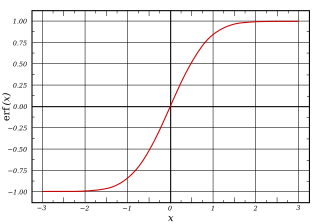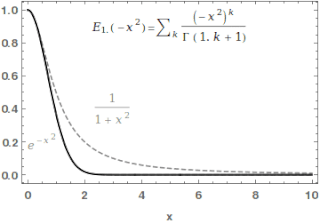
Bessel functions, first defined by the mathematician Daniel Bernoulli and then generalized by Friedrich Bessel, are canonical solutions y(x) of Bessel's differential equation
In mathematics, an elementary function is a function of a single variable that is defined as taking sums, products, roots and compositions of finitely many polynomial, rational, trigonometric, hyperbolic, and exponential functions, including possibly their inverse functions.

In mathematics, a holomorphic function is a complex-valued function of one or more complex variables that is complex differentiable in a neighbourhood of each point in a domain in complex coordinate space Cn. The existence of a complex derivative in a neighbourhood is a very strong condition: it implies that a holomorphic function is infinitely differentiable and locally equal to its own Taylor series (analytic). Holomorphic functions are the central objects of study in complex analysis.
In mathematics, the prime number theorem (PNT) describes the asymptotic distribution of the prime numbers among the positive integers. It formalizes the intuitive idea that primes become less common as they become larger by precisely quantifying the rate at which this occurs. The theorem was proved independently by Jacques Hadamard and Charles Jean de la Vallée Poussin in 1896 using ideas introduced by Bernhard Riemann.

In mathematics, the trigonometric functions are real functions which relate an angle of a right-angled triangle to ratios of two side lengths. They are widely used in all sciences that are related to geometry, such as navigation, solid mechanics, celestial mechanics, geodesy, and many others. They are among the simplest periodic functions, and as such are also widely used for studying periodic phenomena through Fourier analysis.

In mathematics, the error function, often denoted by erf, is a complex function of a complex variable defined as:
Integration is the basic operation in integral calculus. While differentiation has straightforward rules by which the derivative of a complicated function can be found by differentiating its simpler component functions, integration does not, so tables of known integrals are often useful. This page lists some of the most common antiderivatives.

In mathematics, a Green's function is the impulse response of an inhomogeneous linear differential operator defined on a domain with specified initial conditions or boundary conditions.
In mathematics, a linear differential equation is a differential equation that is defined by a linear polynomial in the unknown function and its derivatives, that is an equation of the form

In the physical sciences, the Airy function (or Airy function of the first kind) Ai(x) is a special function named after the British astronomer George Biddell Airy (1801–1892). The function Ai(x) and the related function Bi(x), are linearly independent solutions to the differential equation

In mathematics, the upper and lower incomplete gamma functions are types of special functions which arise as solutions to various mathematical problems such as certain integrals.

In mathematics, physics and engineering, the sinc function, denoted by sinc(x), has two forms, normalized and unnormalized.
In mathematical analysis, asymptotic analysis, also known as asymptotics, is a method of describing limiting behavior.

In mathematics, the Mittag-Leffler function is a special function, a complex function which depends on two complex parameters and . It may be defined by the following series when the real part of is strictly positive:

In mathematics, stability theory addresses the stability of solutions of differential equations and of trajectories of dynamical systems under small perturbations of initial conditions. The heat equation, for example, is a stable partial differential equation because small perturbations of initial data lead to small variations in temperature at a later time as a result of the maximum principle. In partial differential equations one may measure the distances between functions using Lp norms or the sup norm, while in differential geometry one may measure the distance between spaces using the Gromov–Hausdorff distance.
In mathematics, and more specifically in analysis, a holonomic function is a smooth function of several variables that is a solution of a system of linear homogeneous differential equations with polynomial coefficients and satisfies a suitable dimension condition in terms of D-modules theory. More precisely, a holonomic function is an element of a holonomic module of smooth functions. Holonomic functions can also be described as differentiably finite functions, also known as D-finite functions. When a power series in the variables is the Taylor expansion of a holonomic function, the sequence of its coefficients, in one or several indices, is also called holonomic. Holonomic sequences are also called P-recursive sequences: they are defined recursively by multivariate recurrences satisfied by the whole sequence and by suitable specializations of it. The situation simplifies in the univariate case: any univariate sequence that satisfies a linear homogeneous recurrence relation with polynomial coefficients, or equivalently a linear homogeneous difference equation with polynomial coefficients, is holonomic.

In analytic number theory, the Dickman function or Dickman–de Bruijn functionρ is a special function used to estimate the proportion of smooth numbers up to a given bound. It was first studied by actuary Karl Dickman, who defined it in his only mathematical publication, which is not easily available, and later studied by the Dutch mathematician Nicolaas Govert de Bruijn.
In mathematics, Liouville's theorem, originally formulated by Joseph Liouville in 1833 to 1841, places an important restriction on antiderivatives that can be expressed as elementary functions.
In mathematics, the super-logarithm is one of the two inverse functions of tetration. Just as exponentiation has two inverse functions, roots and logarithms, tetration has two inverse functions, super-roots and super-logarithms. There are several ways of interpreting super-logarithms:

In physics, engineering, and applied mathematics, the Bickley–Naylor functions are a sequence of special functions arising in formulas for thermal radiation intensities in hot enclosures. The solutions are often quite complicated unless the problem is essentially one-dimensional. These functions have practical applications in several engineering problems related to transport of thermal or neutron, radiation in systems with special symmetries. W. G. Bickley was a British mathematician born in 1893.






































